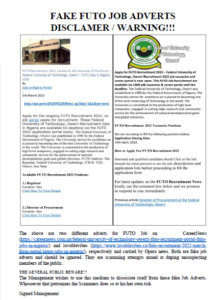Quick Links
- PPRC 2020 Training Programme Timetable
- Center for Human Resource Development
- FUTO Online Research Project Survey
- Open Educational Resources (OER)
- Monthly Weather Digest from IES
- IWoGDS Certificate Course
- Google Scholar Citations
- Other Application Forms
- Certificate Verification
- FUTO News Bulletin
- Anti-Plagiarism
- Online Library

